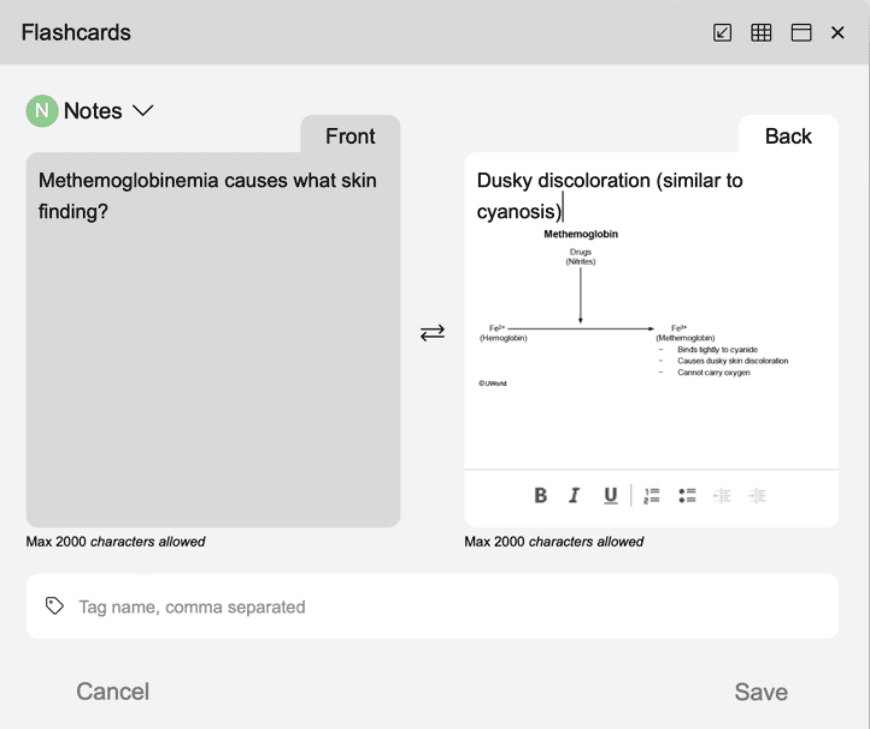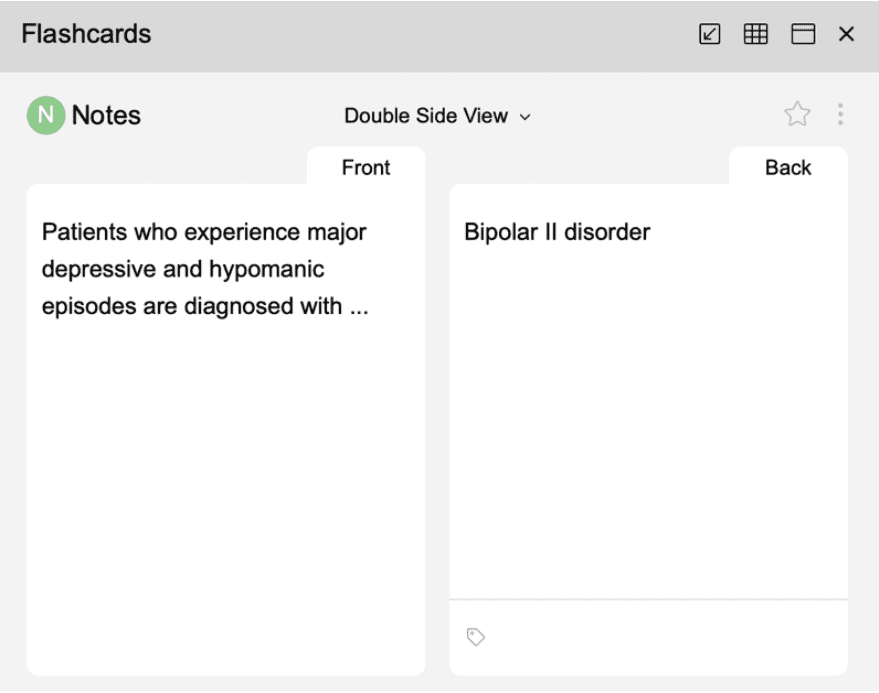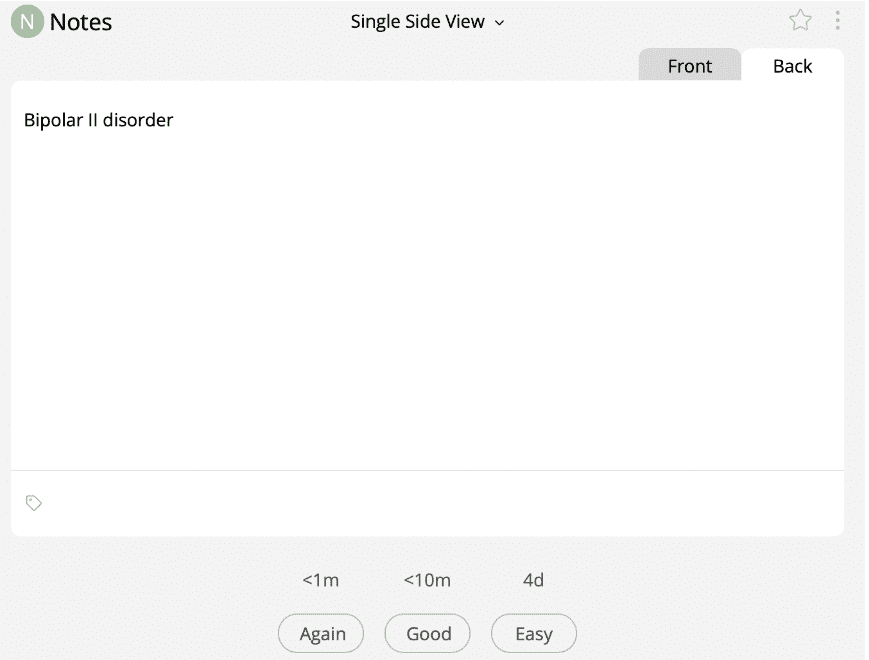How to Make the Most of UWorld USMLE Step 1 Flashcards

4413 Views
Spaced repetition is a learning technique that is very useful for learning and remembering information over an extended time. Many students find it to be essential to their study habits in medical school. It can be especially important when preparing for Step 1, which tests all the basic science knowledge that students learn in the first 1.5 to 2 years of medical school. Spaced repetition is usually done with flashcards, which force the learner to use active recall to remember a concept. Flashcards are retested at increasingly longer intervals as you learn the concepts, encoding them into long-term memory. In this blog, we will cover some of the basics and our tips for using UWorld flashcards to study for USMLE Step 1, so that you can be prepared on test day!
When creating a Step 1 study plan for a student, I always highlight that the two most important components of their schedule are practice questions with UWorld and spaced repetition flashcards. There are several apps and websites you can use to create your own flashcards or download those created by others. However, UWorld’s flashcard feature provides a convenient option for creating cards directly from the content in UWorld questions and explanations. They have put out a comprehensive manual for how to create, organize, and study your flashcards which is a great reference. Here I’ll summarize how to get the most from your UWorld flashcards for USMLE Step 1.
Creating USMLE Step 1 Flashcards in UWorld
As you review completed questions in the UWorld Step 1 question bank, you’ll notice that there are very thorough explanations for the reasoning behind each question and the correct answer. UWorld also provides explanations for why each incorrect answer was not the best choice. After this, there is an educational objective, summarizing the main take-away point for each question. I recommend that students make 1-3 flashcards for each incorrect question, focusing most of their flashcards on the educational objective. While reading the explanation, you can simply highlight the text you would like to add to a flashcard and choose the option to “Add To New Card.” You can also select the lightning-bolt symbol (at the top left of the screen if your interface is set to UWorld, bottom right if it is set to NBME) to access and create flashcards.
Designing Your Flashcards for Effective Learning
UWorld has many images incorporated into their explanations, and these can be helpful to include on your flashcards. There are numerous ways you could design each flashcard, and this can vary depending on the material and your learning style. As a general rule, you should keep your flashcards brief. They should ideally test one concept per card. For example, from the following educational objectives, I could make several different styles of high-yield cards.


You also have the option to create cards based on materials outside of UWorld, which can be very helpful to incorporate other study resources while keeping all your flashcards in one place. Simply select the flashcards tab and choose “+New Card”.
Organizing Your UWorld Flashcards
To organize your cards, I would recommend using the Tag feature as you make each card. You can add a tag for the subject, system, and topic that UWorld displays at the bottom of each question explanation. This will make it easier to search through your cards in the future if you need to quickly reference a particular topic. After you have created flashcards, you can access them through the “Flashcards” tab on your UWorld homepage. You’ll notice in this tab that all your flashcards appear under a default “Notes” deck. If you would like, you can create new decks and organize your cards by subject or system. However, I suggest keeping all your cards in one deck so that you can study the concepts somewhat “at random”. This helps to mimic your real exam, where questions are not grouped by subject or system but can appear at any time.
Using Your USMLE Step 1 Flashcards Effectively
To study your cards, choose the study tab and select the deck. You’ll notice that the number of new cards appears in blue, the cards you are learning appear in red, and the cards to review appear in green. New cards are cards you have created but, have not reviewed yet. Once you see a new card for the first time, it will move into “learning”. Each time you review a card, test yourself and guess the answer before checking it. The first time you see a new card, choose the option “good”.

Every subsequent time you see the card, choose “again” if you were not able to answer it, or “good” if you were. I recommend against ever picking “easy”. If it is truly that easy, you probably do not need to make a flashcard on it. The time above each answer option is the interval at which the card will appear again. Once you have learned a card, it will move to “review” and you will see it again the next day and then at increasingly longer intervals.
My usual advice to students in their dedicated study period is to complete all their flashcard reviews in the morning. You will complete blocks of practice questions throughout the day and create new flashcards as you review these questions. At the end of the day, study all your new flashcards. The most important thing you can do with flashcards and spaced repetition is to keep up with your reviews daily. Spaced repetition is an effective study method, but you must be consistent for it to be useful.
Now Go Forth and Study!
Remember to refer to the comprehensive manual for creating flashcards if you need any help. UWorld’s flashcard feature can help you learn and study the concepts you need to be successful on Step 1.
For more information on UWorld’s Step 1 QBank, click here. If you are looking for some extra help, consider enlisting the help of a 1-on-1 USMLE Step 1 tutor! Schedule your free consultation today to learn more about how Elite Medical Prep tutoring can help you succeed!
Featured Articles





